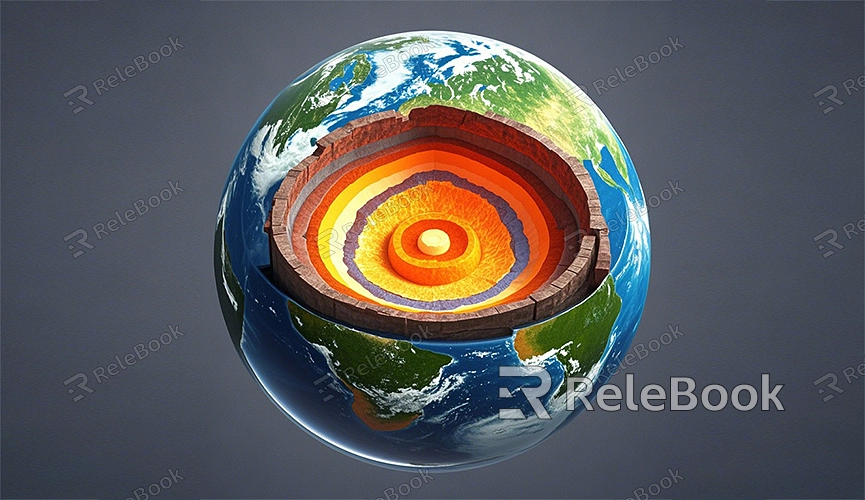How to make a 3d model of earth layers
Creating a 3D model of Earth's layers not only helps us visualize the structure of our planet more intuitively but also serves as a powerful tool for education, research, or presentations. Earth consists of several distinct layers, each with unique characteristics and functions. With 3D modeling software, we can accurately represent these layers. This guide will walk you through the process of making a 3D model of Earth’s layers, helping you master this skill with ease.

Preparation
First, you need a robust 3D modeling software. Blender is an excellent choice as it is free and has extensive community support. Other software such as Cinema 4D or Maya can also be used to create a 3D model of Earth’s layers. Choose the software you are most familiar with to speed up the learning process.
Before starting the modeling, it’s essential to understand the basic structure of Earth’s layers. The Earth can be divided into the crust, mantle, outer core, and inner core. In 3D modeling, we use spheres to represent these layers, with each layer’s size, material, and color corresponding to the actual structure of the Earth.
Creating the Crust
The crust is Earth’s outermost layer. Although relatively thin, it is where we live. In 3D modeling, the crust is typically represented as a sphere. You can create a sphere in Blender using the “Add” function and adjust its size with the scaling tool to represent the outermost layer.
To enhance realism, apply terrain textures to the crust. High-quality terrain textures can depict mountains, oceans, and continents. If you need high-quality 3D textures and HDRIs for creating models and virtual scenes, you can download them for free from [Relebook](https://textures.relebook.com/). Relebook offers a vast collection of premium resources to make your model more lifelike.
Building the Mantle
Beneath the crust lies the mantle, which occupies most of Earth’s volume. The mantle can be represented by a sphere slightly smaller than the crust. In your 3D software, you can duplicate the crust’s sphere and scale it down to represent the mantle.
The mantle’s material should simulate the appearance of rock, typically in dark red or deep orange colors to reflect its high-temperature state. Adjust the color and detail textures in the material nodes to give the mantle more depth. For a more refined effect, you can use volumetric materials to show the transitions within the mantle.
Outer Core and Inner Core
Next are Earth’s core components: the outer core and the inner core. The outer core is liquid and composed of metals like iron and nickel. In 3D modeling, the outer core can be represented by a sphere smaller than the mantle. Choose a metallic material for the outer core and use smooth reflections to represent its liquid nature.
The inner core is Earth’s deepest part, made of solid iron-nickel. In your 3D model, duplicate the outer core’s sphere and scale it down further to represent the inner core. The material for the inner core should be smoother and have a metallic quality, with colors like silver or gold to highlight its unique physical properties.
Layered Model Display
To clearly showcase the Earth’s layered structure, use Boolean operations to slice the model. This will remove portions of the surface, revealing the internal layers. In Blender, you can use the “Boolean” modifier to perform this operation. Select the crust or other layers, use the modifier to cut away parts, and expose the mantle, outer core, and inner core.

This technique allows your Earth model to display the relationships between layers, helping viewers better understand the complex structure of our planet.
Rendering and Presentation
Once modeling is complete, you can start rendering. To make your model more vivid, add appropriate lighting and backgrounds. Use parallel or point lights to illuminate the Earth model and highlight the details of each layer. Additionally, HDRI maps can provide more realistic lighting effects for the scene. Add HDRI maps through Blender’s world nodes for natural environmental lighting.
Adjust the lighting and materials, choose a suitable rendering engine (such as Blender’s Cycles engine), and ensure that the sampling rate in the rendering settings is high enough to avoid image noise. After rendering, you will have a high-quality 3D model of Earth’s layers.
With the steps outlined in this guide, you now know how to create a 3D model of Earth’s layers. From the crust and mantle to the outer core and inner core, each layer requires different modeling techniques and material choices. Mastering these skills will not only enable you to create a complete Earth model but also explore more possibilities in 3D modeling.
If you need high-quality 3D textures and HDRIs for your models and virtual scenes, download them for free from [Relebook](https://textures.relebook.com/). For beautiful 3D models, visit [Relebook](https://3dmodels.relebook.com/), where you can find a wealth of premium 3D resources. I hope these tips help you create outstanding 3D models.

